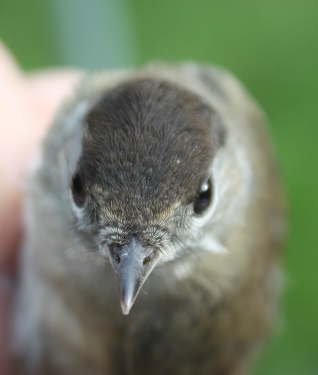With yesterday's weather forecast being for the wind to get up and the rain to be heavy by 10:00 am, I decided to postpone CES visit 6 until today. Yesterday, instead, I did my second breeding bird survey (BBS) visit to Brown's Farm (loads of Yellowhammer, Linnet, Skylark and House Sparrow in the hedgerows and over 20 Hares in the fields, unfortunately no Quail this year, yet - I love the place). The BBS takes me about 2 hours to complete and, with a 6:00 start, I was leaving at about 8:00. The forecast was 100% accurate: by the time I got home (about 8:30) it was spitting with rain and it grew steadily worse. Today, by contrast, was calm, dry and reasonably warm. Fortunately, Jonny was able to rearrange his schedule and join me and we had a very comfortable ringing session.
Catches are still down on last year: everything is a week or so late and the absence of titmice is noticeable. For example, in the corresponding visit last year we caught 17 juvenile Blue Tits, this year 1; 8 juvenile Great Tits, this year 2. This seems to be the story of 2016 so far: a terrible year for titmice. Nonetheless, we had a good and varied catch, as follows: Kingfisher 1; Blue Tit 1; Great Tit 2(1); Wren 1(1); Dunnock 1(2); Robin 3; Song Thrush (1); Blackbird 2(4); Sedge Warbler 1; Blackcap 9(1); Garden Warbler 5(1); Whitethroat 2; Lesser Whitethroat 1; Chiffchaff 7(2); Willow Warbler 1(3); Chaffinch 1; Greenfinch 2; Bullfinch (1). Totals: 40 birds ringed from 16 species; 17 birds retrapped from 10 species, making a total of 57 birds processed from 18 species.
This catch delivered our first juvenile Wren, Garden Warblers, Whitethroat, Lesser Whitethroat, Chaffinch and Greenfinch and second juvenile Kingfisher of the year. Of the 57 birds processed, 34 of them were juveniles. One of the juvenile Blackcaps had a very dark crown. It hadn't started its post-juvenile moult, so it was clearly born with the feathers with this colour. I have seen dark-crowned juveniles before but this one seems particularly dark.

We caught an adult female Willow Warbler who had already started her post-breeding moult, with 5 of her old primaries already replaced by newly growing feathers, and her tail completely gone and in the early stages of regeneration (we checked - there were no tail feathers in or around the net, nor in the holding bag).
The juvenile Whitethroat hadn't yet started its post-juvenile moult: whereas the juvenile Lesser Whitethroat, Sedge Warbler, Chaffinch, Greenfinch and a couple of the Willow Warblers, Garden Warblers and Blackcaps were well into post-fledging moult. We are having a decent year for Kingfishers, with another juvenile caught today, bringing the total ringed this year to 4 (the same as last year, only these have been caught in singles and last year three were caught in one session). The downside so far this year is the absence of Cetti's Warbler: they are around the site but seem to have moved away from our ringing area.
With the breeze getting up and rain threatening, we ended the catching at 11:00 and were packed up and leaving site 45 minutes later. ST / JC
